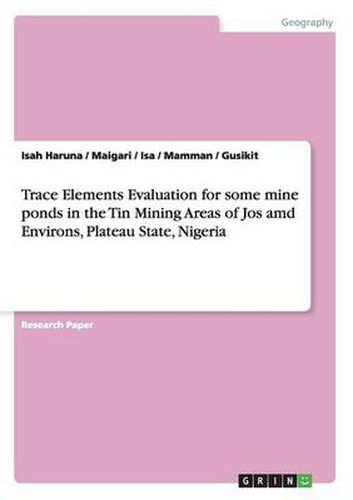Readings Newsletter
Become a Readings Member to make your shopping experience even easier.
Sign in or sign up for free!
You’re not far away from qualifying for FREE standard shipping within Australia
You’ve qualified for FREE standard shipping within Australia
The cart is loading…






Research Paper (postgraduate) from the year 2012 in the subject Geography / Earth Science - Geology, Mineralogy, Soil Science, Abubakar Tafawa Balewa University (School of Science), course: Environmental Geology, language: English, abstract: The study area ( Derelict Land ) in Plateau State fall within Y coordinates 1039185m to 1114995m and X coordinates 452385m to 514845m on the Nigeria’s LANDSAT MSS 2001. The approximate area covered by the project is about 3178.1km22 from the satellite image measurements. Six mining areas were involved ( Jos-Bukuru, Rayfield, Sabongidan kanar, Bisichi, Kuru
and Barikin Ladi) in this research. Analysis of land use changes confirmed that mining is rapidly claiming most of land. Preliminary application of Remote Sensing and Geographical Information System (GIS) to study satellite image of the mining areas is an attempt to evaluate and characterize the mining areas based on the spectral signatures of mine ponds, inactive abandoned mine dumps and structural pattern of the areas. The analysis of variance of the average trace element concentration from the six mining localities showed that Iron (Fe) is the only trace element that show universal anomaly in all the mining localities compared to WHO (2002) Standards for drinking (0.30ppm). Iron (Fe) anomaly range from 0.39-2.54ppm. Besides Iron (Fe), each mining locality has its unique trace elements anomaly. The overall analysis of variance between the average trace elements concentration in waters from the six tin mining localities compared to the World Health Organization Standards for consumable water confirmed anomalies of Fe, Pb, Cr, Co, Cu, Ni, Cd in waters collected from the mining localities which portrays environmental degradation as well as a tendency for pollution. The distribution of trace elements anomalies appeared to be consistent with increase in population and industrialization in the order; Jos > Barikin Ladi >Rayfield. The solution calls for intensive utilization of
$9.00 standard shipping within Australia
FREE standard shipping within Australia for orders over $100.00
Express & International shipping calculated at checkout
Stock availability can be subject to change without notice. We recommend calling the shop or contacting our online team to check availability of low stock items. Please see our Shopping Online page for more details.
Research Paper (postgraduate) from the year 2012 in the subject Geography / Earth Science - Geology, Mineralogy, Soil Science, Abubakar Tafawa Balewa University (School of Science), course: Environmental Geology, language: English, abstract: The study area ( Derelict Land ) in Plateau State fall within Y coordinates 1039185m to 1114995m and X coordinates 452385m to 514845m on the Nigeria’s LANDSAT MSS 2001. The approximate area covered by the project is about 3178.1km22 from the satellite image measurements. Six mining areas were involved ( Jos-Bukuru, Rayfield, Sabongidan kanar, Bisichi, Kuru
and Barikin Ladi) in this research. Analysis of land use changes confirmed that mining is rapidly claiming most of land. Preliminary application of Remote Sensing and Geographical Information System (GIS) to study satellite image of the mining areas is an attempt to evaluate and characterize the mining areas based on the spectral signatures of mine ponds, inactive abandoned mine dumps and structural pattern of the areas. The analysis of variance of the average trace element concentration from the six mining localities showed that Iron (Fe) is the only trace element that show universal anomaly in all the mining localities compared to WHO (2002) Standards for drinking (0.30ppm). Iron (Fe) anomaly range from 0.39-2.54ppm. Besides Iron (Fe), each mining locality has its unique trace elements anomaly. The overall analysis of variance between the average trace elements concentration in waters from the six tin mining localities compared to the World Health Organization Standards for consumable water confirmed anomalies of Fe, Pb, Cr, Co, Cu, Ni, Cd in waters collected from the mining localities which portrays environmental degradation as well as a tendency for pollution. The distribution of trace elements anomalies appeared to be consistent with increase in population and industrialization in the order; Jos > Barikin Ladi >Rayfield. The solution calls for intensive utilization of